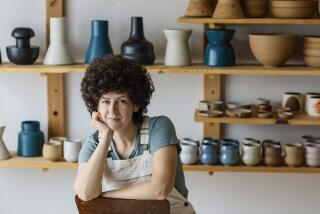Bringing back memories with pottery display.
- Share via
With its sand and surf, boutiques and view homes, Manhattan Beach is a far cry from an industrial town.
But for decades, it was a four-acre factory in the middle of downtown that gave the city an international reputation.
Metlox Potteries--with its vividly colored dinnerware, rooster-shaped pitchers, curving avant-garde candy dishes, and delicate miniature sea horses and flamingos--reigned as one of Southern California’s big five pottery makers until it closed in bankruptcy last year. Its wares were sold worldwide.
“It was the first and only industry Manhattan Beach ever had,” said Keith Robinson, president of the city’s Historical Society, which is spotlighting the art of Metlox as the first rotating exhibit in the society’s new museum at Polliwog Park.
During its golden age in the 1950s, Metlox operated round the clock, with 500 workers filling three shifts. These days, Metlox creations have joined the ranks of collectibles, with some pieces by Carl Romanelli--who was the art ware designer between 1939 and 1943--selling for $1,000.
Robinson said pottery buffs from outside Manhattan Beach have been visiting the exhibit. He added that he hopes the show will temper the city’s more recent reputation as the home of the McMartin Pre-School child molestation case. “It’s nice to have a positive aspect,” he said.
The museum, which opened a month ago, occupies a steep-roofed, maroon 1905 beach cottage that was moved to the park and restored. The former living room contains an illustrated community time line dating from the city’s birth as a resort, when a lot and cottage were priced at $700. Files of documents and photos kept in a small, one-time back bedroom are available to researchers.
The Metlox show, which will be followed by an exhibit on the famed Red Car trolleys that once linked Southland communities, is in what used to be the kitchen.
With its shelves and tables of ceramics and detailed written narrative, the show tells the story of a company that kepts its eye on changes in the economy and popular tastes, eventually succumbing to less-expensive imports.
Metlox began in 1927 as a manufacturer of neon-lighted ceramic signs, including the first marquee of the Pantages Theater in Hollywood. The Depression put a dent in the sign business, so Metlox turned to dinnerware in vivid and glistening yellows, oranges and greens.
According to artist and pottery expert Jack Chipman, who appears in a museum video about the exhibit, the dinnerware cheered people during those hard times and went perfectly with California patio living. “This was a big hit,” he said.
Birds, deer, frogs, penguins and other art miniatures came in with Romanelli, who Chipman said was a local sculptor happy to have the work. After World War II, Metlox boomed with production of Bambi and other Disney movie creatures.
The 1950s saw the California Mobile style of tall, tapered pitchers and free-form bowls and dishes with designs resembling colorful mobiles.
Metlox declined during the 1980s as cheaper, foreign-made pottery undercut its pricier items. The death knell came last year when the federal Environmental Protection Agency ordered Metlox to clean up a toxic pit that had been created by decades of runoff from glaze production at the factory. The company went bankrupt and closed, angering some officials who accused Metlox of bad faith in not dealing with the cleanup. Property owners are cleaning the site so it can be redeveloped.
In an interview, Chipman said that of the major Southern California pottery works, Metlox had the best overall variety, mingling the futuristic California Mobile style with traditional lines depicting farmhouses and fields.
The exhibit of more than 100 pieces is replete with the ‘30s dinnerware, Romanelli miniatures, the California Mobile pieces, and creations as diverse as dinosaur- and pineapple-shaped cookie jars.
Jan Dennis, author of a Manhattan Beach history, says the exhibit is a memory-jogger for people who worked at Metlox or bought its wares. “They say, ‘I remember that when I got married 40 years ago’, or, ‘I remember when my mother bought that,’ ” said Dennis. “The Historical Society is bringing back a lot of memories with this pottery.”


